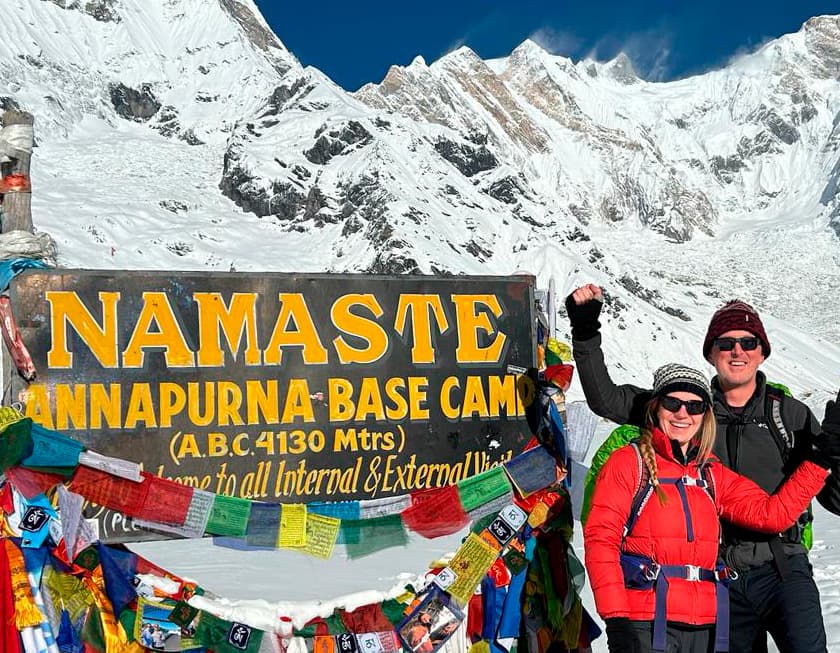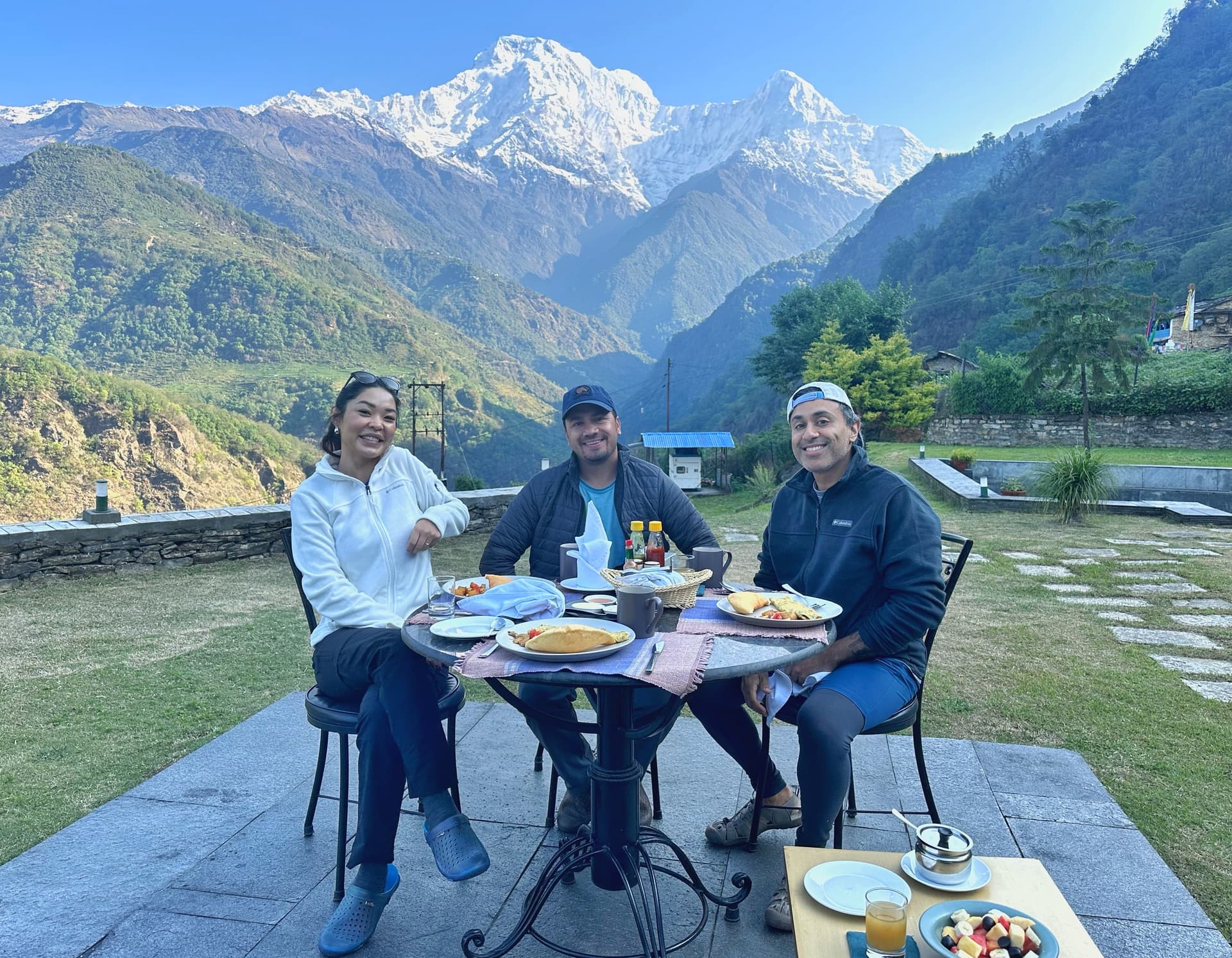Annapurna Base Camp Trek
- DestinationNepal
- Duration14 days
- Trip DifficultyModerate
- ActivitiesTrekking
- AccommodationHotel/Guesthouse
- MealsB.L.D
- Max. Elevation4130m.
- Group SizeMin. 1 Pax
- Best TimeMarch - May & Sept - Dec
Main Overview
The 14-day Annapurna Base Camp Trek with Nepal Hiking Team offers something rare: a Himalayan journey that feels complete yet accessible. In one fluid progression, you’ll pass from rice terraces and rhododendron forests into glacier basins framed by 8,000-meter peaks. Along the way, encounter sacred shrines, stay in village teahouses, and follow trails lined with prayer flags and cascading waterfalls.
Unlike routes that focus on a single landscape or push into isolated altitude, this trek delivers a full blend of scenery, culture, and connection. One day you’re sipping tea beneath Machhapuchhre’s ridgeline. The next, watching sunrise from Poon Hill or soaking your legs in a riverside hot spring. The trail evolves naturally—from mossy forests and stone staircases to a high alpine basin surrounded by Himalayan giants.
Designed for trekkers with moderate fitness, this experience offers immersion without rush. Each day brings steady movement and quiet reward. With support from Nepal Hiking Team’s expert guides, welcoming teahouses, and a balanced itinerary, this journey invites new and returning hikers seeking something more than mountain views —it brings rhythm, richness, and real connection.
Annapurna Base Camp Trek Highlights
- Begin in Kathmandu and Pokhara, blending urban culture and lakeside calm before heading into the mountains.
- Trek through Gurung and Magar villages, walk the legendary 3,000 steps to Ulleri, and experience fireside hospitality in family-run teahouses.
- Watch a golden sunrise from Poon Hill (3,210m)—one of Nepal’s most iconic Himalayan viewpoints.
- Follow forest trails filled with rhododendrons, waterfalls, and sacred shrines, entering landscapes rich in wildlife and spiritual symbolism.
- Ascend into the Annapurna Sanctuary, where ten Himalayan peaks—including Annapurna I and Machhapuchhre—surround you in a glacier-carved amphitheater.
- Reach Annapurna Base Camp (4,130m), celebrate your arrival beneath towering summits, and wake to a sunrise that etches itself into memory.
- Descend via Jhinu Danda’s riverside hot springs, then return to Pokhara and Kathmandu—closing your loop with mountain stories you’ll carry for life.
Route Overview
Your Annapurna Base Camp Trek begins in the historic capital of Kathmandu before continuing to Pokhara, where the lakeside calm sets the tone for the adventure ahead. From Birethanti, the trail climbs gradually through farming terraces and into the stone villages of Ulleri and Ghorepani. These early days bring you close to village life, and high enough to witness the changing vegetation with every step.
From Ghorepani, you hike to Poon Hill for a panoramic sunrise. This is your first true “mountain moment”—a silent hour as the Annapurna and Dhaulagiri ranges shift from pink to gold. The trail continues to Chuile and on to Chhomrong, where the path narrows and the peaks draw closer. You follow the Modi River into deeper gorges and forests, stopping at places like Bamboo and Deurali—teahouse settlements tucked under cliffs and waterfalls.
From Machhapuchhre Base Camp, it’s a final push to Annapurna Base Camp. You arrive into a world of snow and stone, silence and height. This is the heart of the journey—where every emotion feels sharper.
After celebrating your arrival, you descend through the same route but detour to Jhinu Danda, where the hot springs provide a soft, natural reward. A short hike brings you to the road, and from there, a jeep returns you to Pokhara. You’ll close the loop in Kathmandu—feet tired, heart full.
Alternative Trips
If you’re short on time or looking for a different approach, we offer several adapted versions of the Annapurna Base Camp Trek. Each one keeps the heart of the journey but tailors the pace or finish for your style.
Short Annapurna Base Camp Trek – 11 Days
Perfect for trekkers on tighter schedules. The ABC 11-day version removes a night in Pokhara and shortens two trekking days—ideal for those who want the full route in less time.
Annapurna Base Camp Heli Return Trek – 9 Days
Trek up to base camp and fly back to Pokhara by helicopter. A scenic, fast-paced option with a luxurious finish.
Annapurna Panorama Trek – 9 Days
Stay at lower elevations with no base camp push. Annapurna Panorma route focuses on culture, rhododendron forests, and viewpoints like Poon Hill—great for families or those preferring easier terrain.
Annapurna Luxury Trek – 10 Days
Experience the beauty of the Annapurna with premium lodges, easier pacing, and high comfort throughout.
Itinerary
Day 01: Arrive at Tribhuvan International Airport, Kathmandu
Upon arrival at Tribhuvan International Airport, our representative will be waiting outside the terminal with a Nepal Hiking Team placard. From there, we’ll transfer you to your hotel in central Kathmandu.
Once you arrive at the hotel, we’ll hold a short briefing about the trek and introduce your guide. At the same time, we’ll hand over the gear for your trip—sleeping bag, down jacket, and duffel bag.
We’ll also collect a copy of your passport and travel insurance for our records. Afterward, you’re free to organize your gear or explore the nearby streets of Thamel.
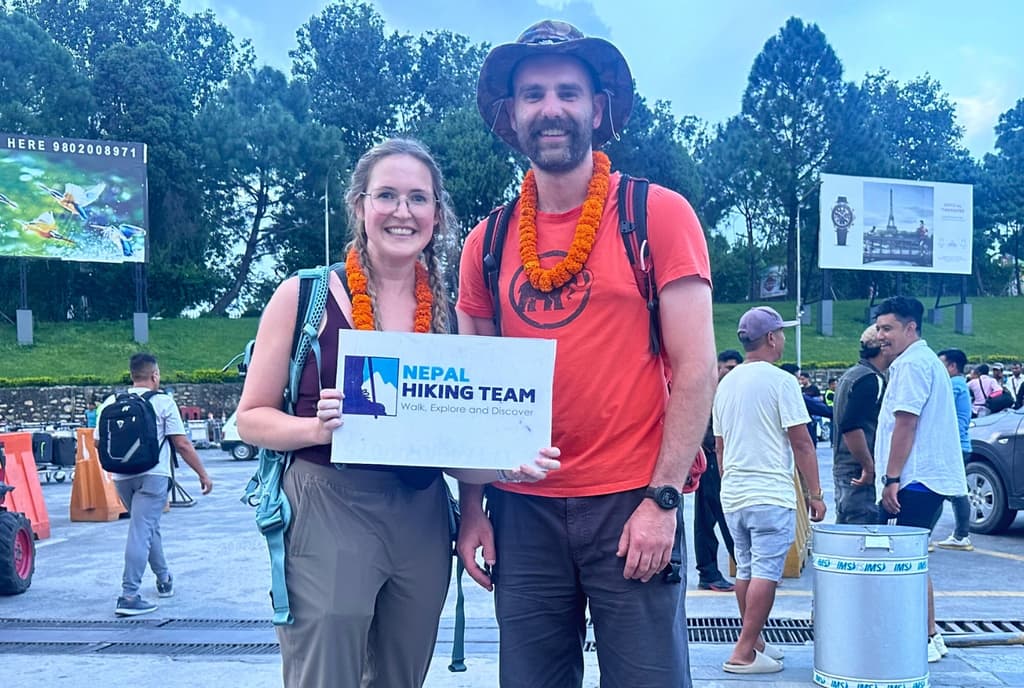
Day 02: Drive from Kathmandu to Pokhara (845m/2,772ft), 6-7 hours drive, 204 km
After breakfast at the hotel, we begin our journey with a scenic drive to Pokhara, a peaceful city nestled beside Phewa Lake. The drive takes about 6 to 7 hours and follows a winding highway along rivers, hillsides, and small towns.
Throughout the ride, you’ll see local villages, terraced fields, and glimpses of rural life across central Nepal. We stop for breaks along the way to stretch and enjoy the views.
Upon arrival in Pokhara, we check in to a hotel near the lake. The rest of the day is free to relax, walk along the lakeside, or enjoy views of Machhapuchhre rising behind the city.
Overnight in Pokhara.
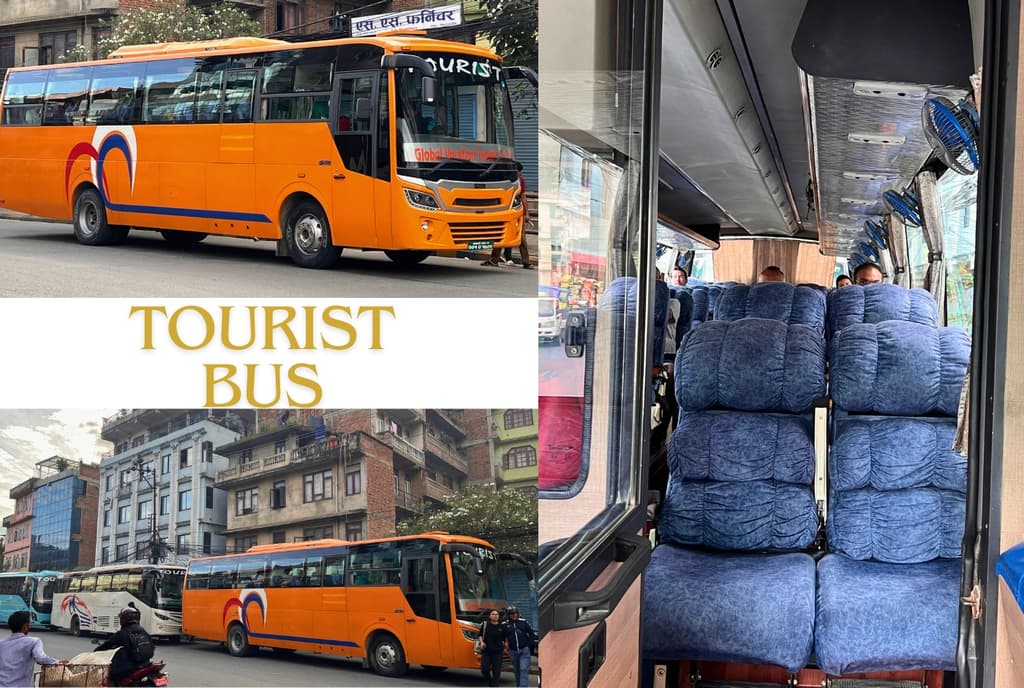
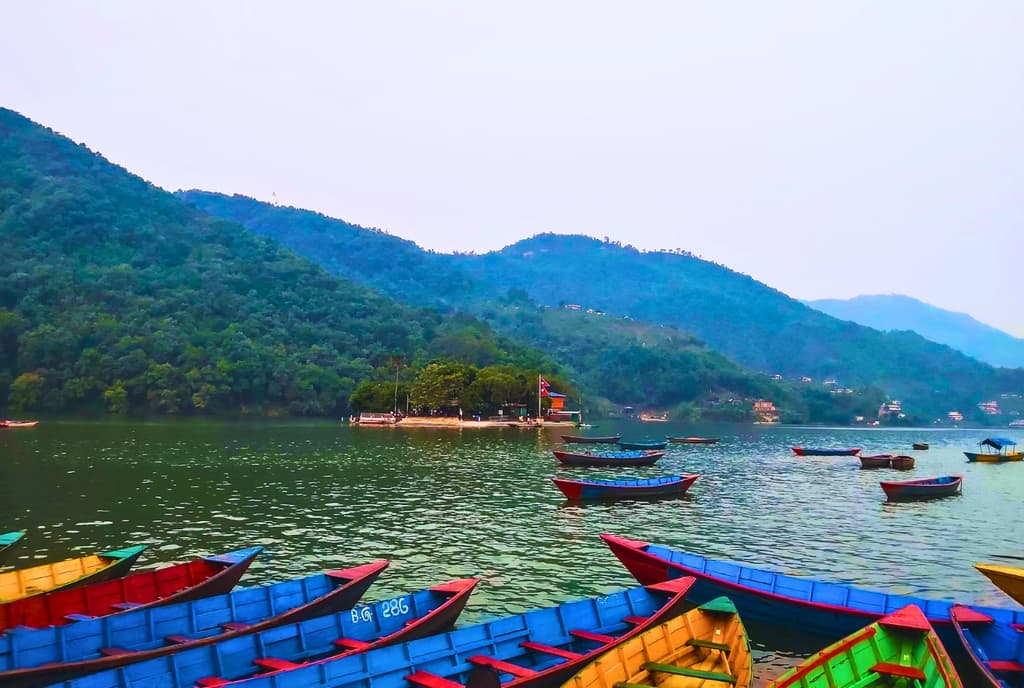
Day 03: Drive to Birethanti, Trek to Ulleri (1,960m/6,430ft), 5 hours, 9–10 km/5–6 miles
We begin the day with a drive from Pokhara to Birethanti, which takes around 1.5 to 2 hours. This small village marks the starting point of our trek into the Annapurna region.
After completing the permit check, we cross the Modi River and start walking through lush valleys and terraced fields. The trail gradually ascends past Sudame and Hile before the final uphill push to Ulleri.
The last section is a steady climb up stone staircases—over 3,000 steps leading to a hilltop Magar village surrounded by forested ridges and distant peaks.
Overnight in Ulleri.

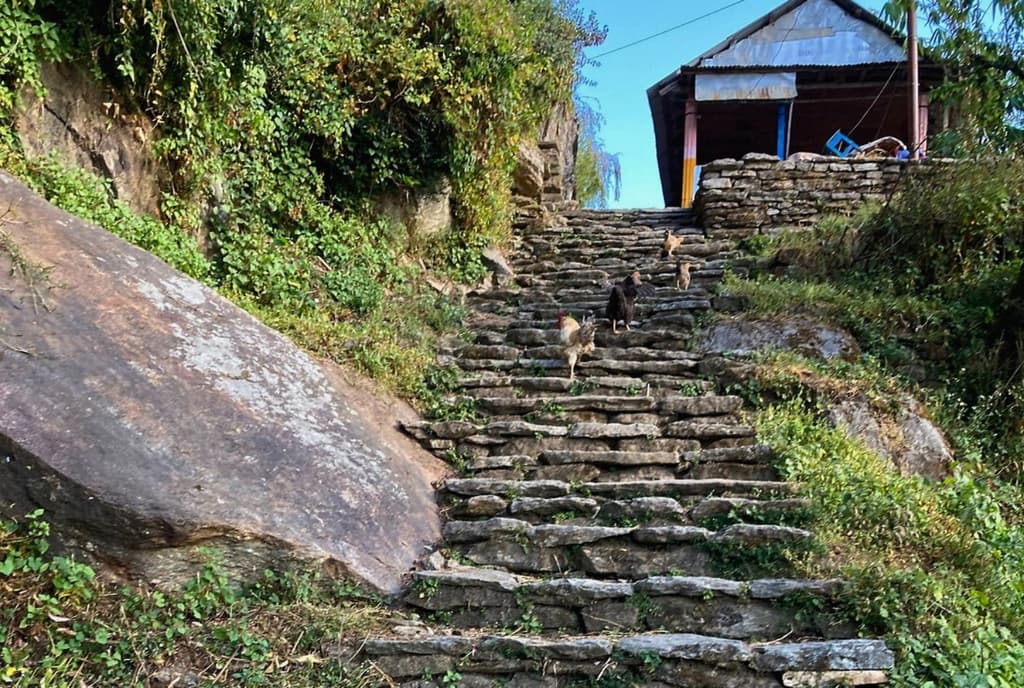
Day 04: Trek to Ghorepani (2,880m/9,448ft), 4-5 hours trek, 8 km/ 5 miles
We leave Ulleri and begin a gradual ascent through thick forests of rhododendron and oak. The trail passes small settlements like Banthanti and Nangethanti, where we stop for a break and enjoy the quiet atmosphere of the woods.
As we gain elevation, the trees start to thin, and snow-capped peaks occasionally appear through the branches. The final stretch brings us to Ghorepani, a scenic village surrounded by mountains and known for its stunning viewpoints.
Overnight in Ghorepani.
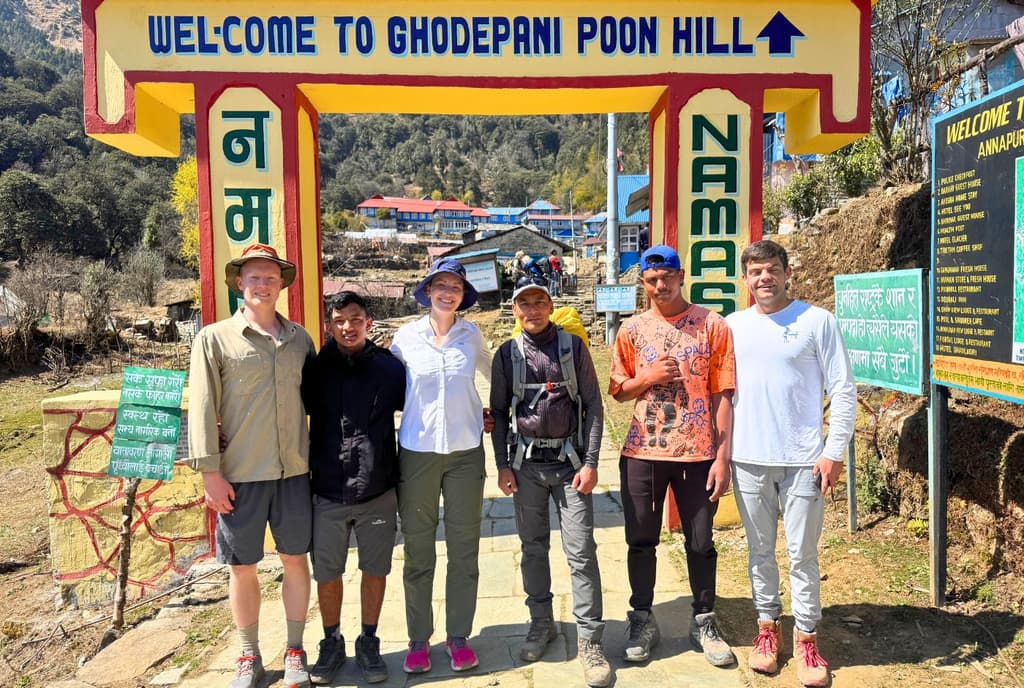
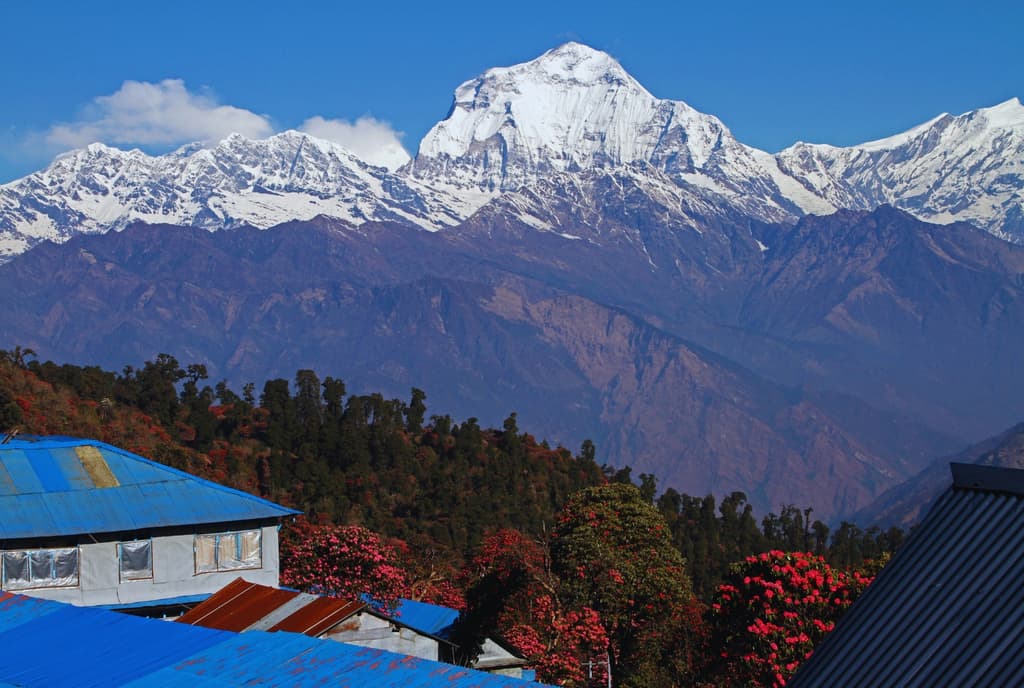
Day 05: Hike to Poon Hill (3,210m) then to Chuile (2,300m), 7–8 hours, 12–14 km/7–8 miles
We start before sunrise with an early morning hike to Poon Hill, carrying headlamps to guide the way. From the top, we enjoy panoramic views of the Himalayas—Annapurna I, Dhaulagiri, Machhapuchhre, and several other peaks glowing in the early light.
After taking in the views, we return to Ghorepani for breakfast. The trail then climbs to Deurali Pass and gradually descends through forest paths, passing waterfalls and peaceful clearings.
From Tadapani, we follow a quieter trail through wooded slopes until we reach Chuile, a small Gurung village overlooking the valley.
Overnight in Chuile.
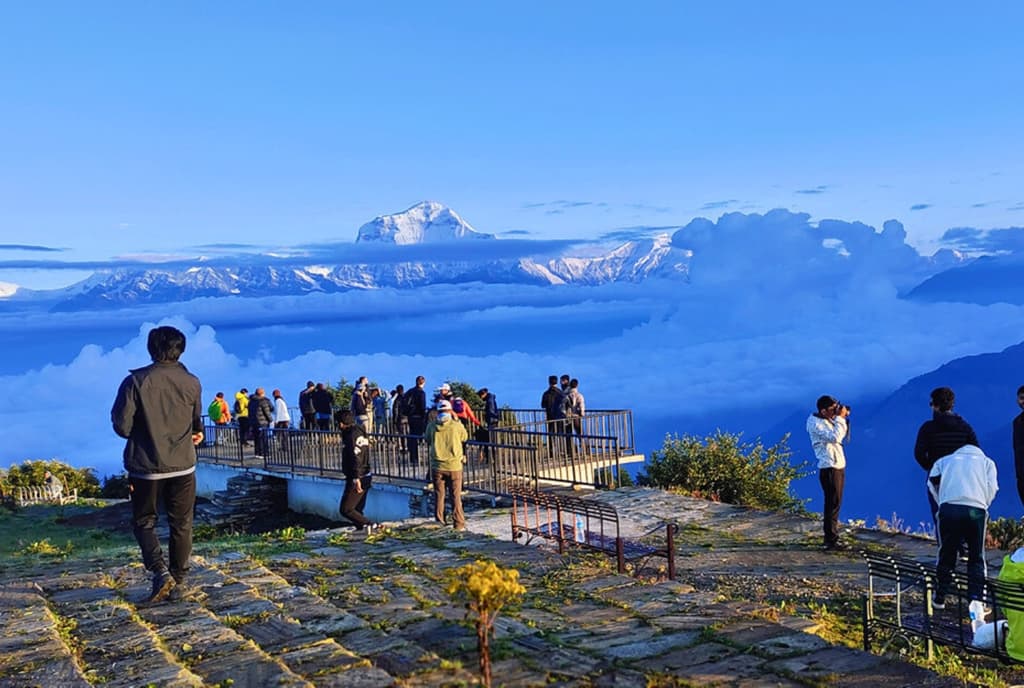

Day 06: Trek Chuile to Chhomrong village (2,170m/7,119ft), 5 hours, 6–7 km/3.7–4.3 miles
We begin with a descent through forested trails toward the Kimrong River. After crossing a suspension bridge, the trail climbs steadily across terraced hillsides and scattered homes, with prayer flags fluttering along the way.
As we gain height, views of Annapurna South and Machhapuchhre open up ahead. The final stretch brings us into Chhomrong, a lively Gurung village perched above the valley. It’s one of the last major settlements before entering the Annapurna Sanctuary.
Overnight in Chhomrong.


Day 07: Trek to Dovan (2,600m/8,530ft), 5–6 hours, 9–11 km/5.6–6.8 miles
We begin with a long descent down stone steps to cross the Chhomrong Khola. From there, the trail climbs steadily to lower and upper Sinuwa, where we take a short break with views of the surrounding peaks.
Continuing through dense rhododendron and bamboo forests, we pass Bamboo village and follow a quiet trail alongside the river. The final section leads us to Dovan, a small settlement tucked into the forest, surrounded by cliffs and greenery.
Overnight in Dovan.


Day 08: Trek from Dovan to Deurali (3,230m/10,597ft), 4–5 hours, 6–7 km/3.7–4.3 miles
We leave Dovan and follow a gradually rising trail through bamboo and oak forests. Along the way, we pass waterfalls and a sacred rock shrine where locals often pause to offer respect.
After a short rest at Himalaya, we continue toward Hinku Cave, a well-known shelter once used by herders and climbers. From here, the landscape turns more rugged as we approach Deurali, a higher-altitude stop nestled among cliffs and icy streams.
Overnight in Deurali.


Day 09: Trek to ABC (4,130m/13,549ft) via MBC, 5–6 hrs, 8 km/5 miles
We begin early and follow the trail through a narrow gorge along the Modi River. After a steady climb, we reach Machhapuchhre Base Camp, set beneath the steep face of Fishtail Peak. The views from here already feel dramatic.
Continuing upward, the trail opens into the Annapurna Sanctuary. As the elevation increases, the air becomes thinner and the landscape more alpine. After a final gradual ascent, we arrive at Annapurna Base Camp—surrounded by a circle of towering peaks.
Overnight at ABC.


Day 10: Return to Bamboo (2,310m/7,578ft), 7 hours, 18 km/11.2 miles
We wake early to watch the sunrise over Annapurna I. The light slowly spreads across the surrounding peaks, creating a memorable start to the day.
After breakfast, we begin our descent, retracing the route through Machhapuchhre Base Camp, Deurali, and Dovan. The trail gradually becomes greener as we descend into lower elevations.
By the time we reach Bamboo, we’re back among thick forests and warmer air.


Day 11: Trek to Jhinu Danda Hot Spring (1,780m/5,839ft), 6 hours, 12 km/7.5 miles
We begin by climbing back to Sinuwa and then to Chhomrong. After a short break, the trail descends steeply on stone steps toward Jhinu Danda.
Once we reach the village, you can leave your backpack at the lodge and walk down to the natural hot spring near the river. Surrounded by forest and cliffs, it’s a relaxing way to ease your muscles after several days on the trail.
Overnight in Jhinu Danda.


Day 12: Short hike to Samrung and drive to Pokhara, 2–3 hours, 45–50 km/28–31 miles
After breakfast, we hike down to the suspension bridge at Samrung, crossing the river for the final time on foot. From there, a private jeep will be waiting for the drive back to Pokhara.
Once we reach the city, we check in to the hotel near the lakeside. The rest of the day is free to relax, enjoy the cafés, or take in the views across Phewa Lake.
Overnight in Pokhara.

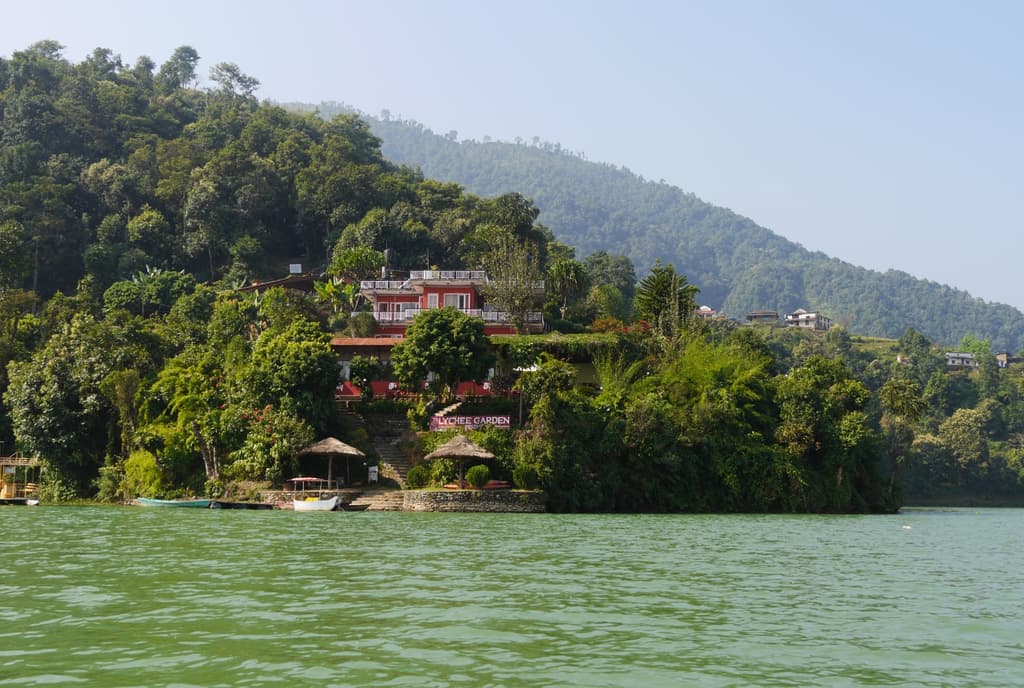
Day 13: Return to Kathmandu (1335m), 6–7 hours drive, 204 km/127 miles
We leave Pokhara in the morning and begin the drive back to Kathmandu. The road follows rivers, terraced fields, and forested hills, offering one last look at Nepal’s rural landscape.
Upon arrival in Kathmandu, we transfer to the hotel. The rest of the day is free to relax or explore the city at your own pace.
Overnight in Kathmandu.
Note: If you are not ready for another long and tiring bus journey, you can take a flight to Kathmandu at an extra cost. It costs USD 115.00 per person for a one-way flight. Inform us in advance if you wish to skip the drive and take a flight instead.
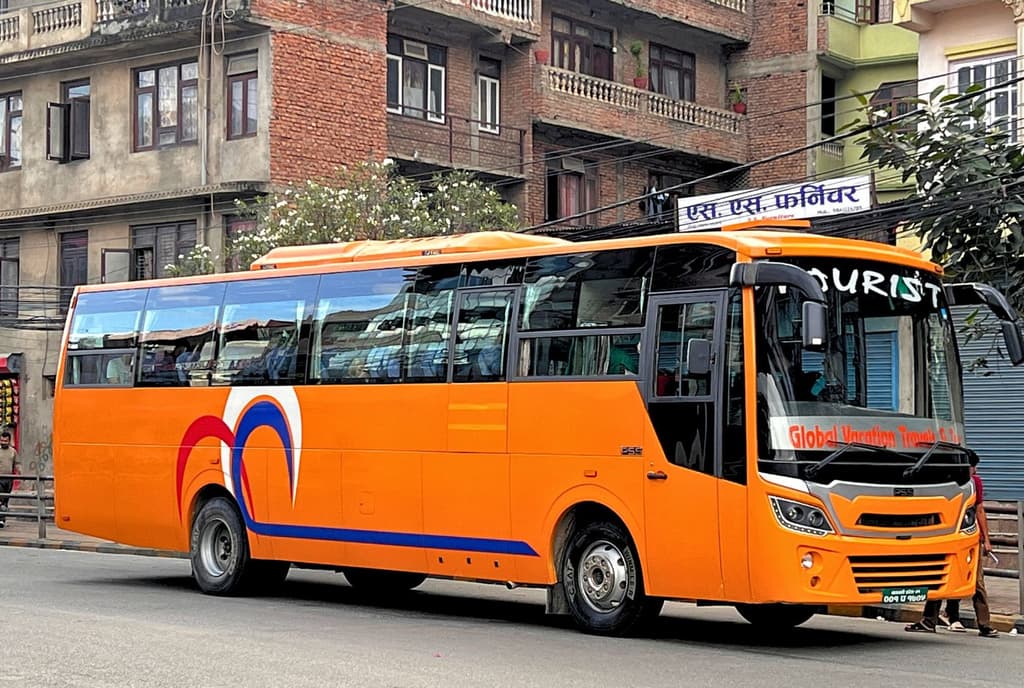

Day 14: Farewell, Transfer to Tribhuwan International Airport (TIA)
We’ll arrange your transfer to Tribhuvan International Airport around three hours before your scheduled international flight. Our team will make sure everything is set for a smooth departure.
If you're planning to explore more of Nepal or return for another adventure, we’ll be happy to help organize your next journey.
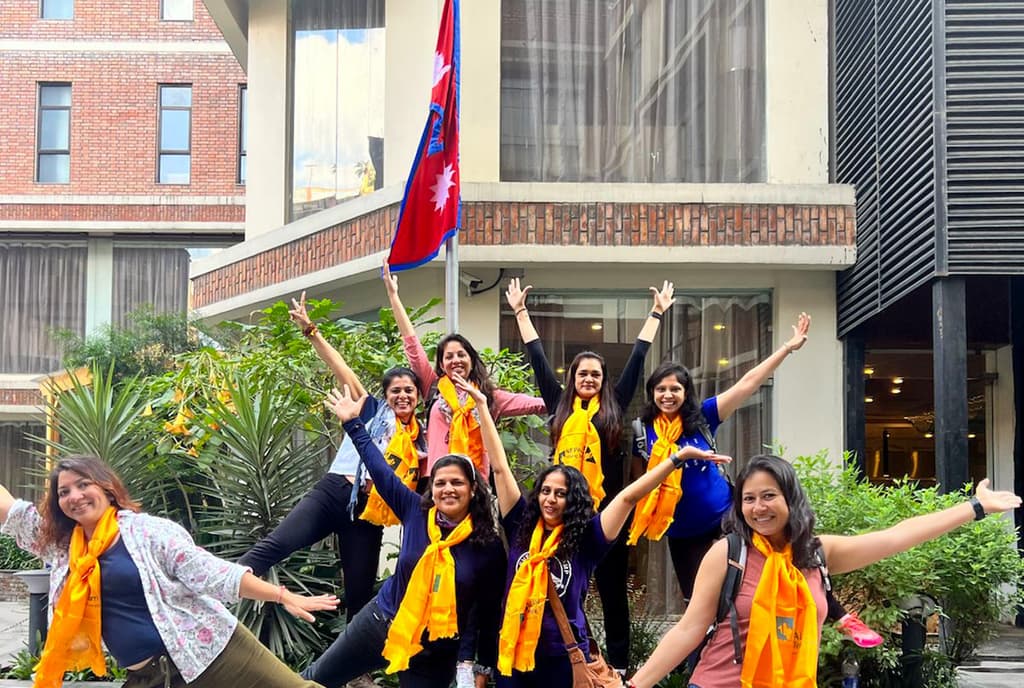
Cost and Date
Start Dates refer to your arrival date in Nepal. End Dates correspond to your return date from Nepal.
The Annapurna Base Camp Trek set departure dates are tailored for the group joining option. If the 14 days Annapurna Base Camp Trek departure dates don’t fit your schedule, we can include alternative dates that better suit your needs.
Cost Includes
- Airport pickup and drop-off using a private vehicle.
- Two nights' accommodation with breakfast at a 3-star hotel in Kathmandu, such as Woodapple Hotel and Spa or a similar establishment.
- Two nights' accommodation with breakfast at a 3-star hotel in Pokhara.
- Surface transfers to and from Pokhara via a tourist bus, followed by a private car transfer to and from Nayapul.
- Full board meals throughout the trek, including breakfast, lunch, and dinner, along with tea/coffee.
- Accommodation in the best available twin-sharing lodges during the trek.
- An experienced English-speaking trekking guide and a porter to carry luggage. The porter ratio is 1 porter for every 2 trekkers. The guide and porter's salaries, insurance, equipment, and meals are all included.
- Provision of a down jacket, four-season sleeping bags, a duffel bag, a t-shirt, and a trekking map. The down jacket and sleeping bag are to be returned after the completion of the trip.
- A comprehensive medical kit for any necessary medical assistance during the trek.
- Handling of all necessary paperwork and permits, including the Annapurna Conservation Area Permit (ACAP) and others. Please bring three passport-sized photographs.
- All applicable government and local taxes.
Cost Excludes
- Meals not specified in the 'Meal Inclusions' section
- Travel Insurance
- International airfare
- Nepal entry visa fees
- All kinds of cold drinks, including water, coke, Fanta, juice, etc.
- Wi-Fi internet during the trek
- Personal trekking equipment
- Tips for airport representatives, tour guides, trekking staff, drivers, etc.
Annapurna Base Camp Trek Route Map

Annapurna Base Camp Trek Video
Annapurna Base Camp Trek Faqs
Why Nepal Hiking Team
Why should I choose Nepal Hiking Team for the Annapurna Base Camp Trek?
We’ve been leading treks to Annapurna Base Camp since 2009, and it remains one of our most trusted routes. Our guides know the trail in detail and have strong relationships with the teahouse owners along the way. We focus on safety, personalized pacing, and consistent on-ground support.
Whether you're traveling privately or in a small group, we adapt to your comfort and needs. With over 2,300 five-star reviews across TripAdvisor, Trustpilot, and Google, our experience and reputation speak for themselves.
Ready to experience the Annapurna Base Camp like never before? Discover the 10 compelling reasons seasoned trekkers choose Nepal Hiking Team.
What is the group size for the Annapurna Base Camp Trek?
We keep our groups small to offer a more personal and flexible experience. The typical group size is around 6 to 8 people, with a maximum of 10 trekkers per group.
Is departure guaranteed even if no one else joins?
Yes. Once your booking is confirmed, your Annapurna Base Camp Trek will run as scheduled, even if you’re the only participant. In rare cases like natural disasters or major strikes, we may recommend alternate dates or routes for safety.
Customization: Private Vs Group
I am a solo traveler. Can I join the Annapurna Base Camp group tours?
Yes, solo travelers are welcome to join our group departures for the Annapurna Base Camp Trek. If no one else books your selected date, we’ll still run the trek for you at the solo rate.
All confirmed trips operate as planned, whether it’s a group or a single guest. It’s also a great opportunity to connect with fellow trekkers while enjoying a fully supported adventure in the Annapurna region.
Can I book a private trip if I’m traveling with friends or family?
Yes, we organize private treks for families, couples, or groups on the Annapurna Base Camp Trek. You’ll have full flexibility with your dates, pacing, and daily schedule.
For two or more people, the cost is the same as joining a group. There’s no maximum size for private bookings, and we’ll customize the trek to fit your preferences.
Can I customize my Annapurna Base Camp trek itinerary?
Yes, we can customize your Annapurna Base Camp trek itinerary to match your preferences. You can add rest days, include sightseeing in Kathmandu, or spend more time in Pokhara after the trek.
If you're traveling with friends or family, we can adjust the pace or schedule based on your needs. All customized treks are arranged as private trips, offering full flexibility throughout.
How does the Short Annapurna Base Camp Trek 11-day differ from the 14-day ABC Trek?
The 11-day ABC version is a faster-paced itinerary designed for travelers with limited time. It includes a flight to Pokhara and begins the trek the same day, without an overnight stay in the city.
This shorter package also eliminates overnight stops at Chhomrong and Jhinu Danda, shortening the number of trekking days. In contrast, the 14-day ABC trek includes a road journey, two hotel nights in Pokhara, and a more gradual pace with extra time on the trail.
What is the key difference between the Instant ABC and 14-day Annapurna packages?
The Instant ABC Trek is an 8-day package with five days of hiking. It covers only the Hinku Valley section of the trail. You’ll fly to Pokhara, drive to Jhinu Danda, and begin the trek to Sinuwa that same day. After reaching Annapurna Base Camp, you return the same way and spend one night in Pokhara before flying back to Kathmandu.
The 14-day Annapurna trek includes a longer route, overland travel, and extra hotel nights. It follows a slower pace, includes the Poon Hill section, and offers more time on the trail.
What makes the Annapurna Base Camp Trek different from the Annapurna Circuit?
The Annapurna Base Camp Trek takes you directly into the heart of the Annapurna Sanctuary. It’s a shorter route, usually completed in 5 to 8 days, and leads to a single destination—Annapurna Base Camp at 4,130 meters—surrounded by towering Himalayan peaks.
The Annapurna Circuit is a longer journey that loops around the Annapurna range and typically takes 12 to 16 days. It includes Thorong La Pass at 5,416 meters and crosses a variety of landscapes, climates, and cultural regions. Both routes are rewarding in their own way.
Arrival in Nepal & Visa Process
Do I need a visa on arrival in Nepal?
Yes, most travelers can obtain a visa on arrival at Tribhuvan International Airport in Kathmandu. Your passport must be valid for at least six months with at least one blank page.
We recommend completing the online visa form in advance and bringing the printed confirmation. You can pay the visa fee at the airport using cash or a card. Some nationalities must apply beforehand, so it’s best to check the current requirements before you travel.
Do you arrange airport pickup and drop-off services?
Yes, we provide airport transfers as part of your Annapurna Base Camp Trek package. When you arrive in Kathmandu, our team will be waiting outside the terminal to welcome you and take you to your hotel.
We’ll also arrange your airport drop-off according to your international flight schedule. If you arrive early or stay extra days, we’ll adjust the timing to match your plans.
Where will I stay in Kathmandu? Can I upgrade the hotel?
For the Annapurna Base Camp Trek, we include a stay at a comfortable 3-star hotel in Thamel—such as Woodapple Hotel & Spa or a similar option, depending on availability.
If you’d like to upgrade to a higher-category hotel, we’re happy to arrange that for an added cost. Just let us know your preference in advance.
How much does an extra night’s accommodation in Kathmandu cost?
For the Annapurna Base Camp Trek, an extra night at our standard Kathmandu hotel costs USD 45 for a single room and USD 50 for a twin or double room. The rate includes breakfast and government taxes. If you plan to arrive early or extend your stay, we can arrange the additional nights for you.
Where will I stay in Pokhara? Can I stay longer, and how much extra?
We arrange your Pokhara accommodation at a 3-star hotel near Lakeside, close to cafés and shops. If you’d like to stay longer after the Annapurna Base Camp Trek, we can book extra nights for you. The rate is USD 40 per night for a single room and USD 45 for a twin or double room.
What happens during the pre-trek briefing in Kathmandu?
For the Annapurna Base Camp Trek, we hold the pre-trek briefing at your hotel in Kathmandu, usually the day before your trek starts. You’ll meet your guide, review the itinerary in detail, and go over your gear checklist.
During the briefing, we’ll hand over your trek equipment—including a duffel bag, sleeping bag, down jacket, map, and T-shirt. We’ll also update you on trail conditions, weather forecasts, and collect your passport, insurance copy, and any remaining balance if applicable.
Booking, Deposit & Payment
How do I book the Annapurna Base Camp Trek? Do I need to pay a deposit?
Booking with NHT is easy. Select your travel dates on our website, fill out the booking form, and confirm your reservation with a 20% deposit using a card. If you prefer to pay later or use a wire transfer, choose the “Book Now and Pay Later” option—we’ll send you a payment link directly.
Once your deposit is received, we’ll confirm your booking. The remaining balance can be paid in Kathmandu before the trek begins, either by card, cash, or wire transfer.
If I cancel my trek, will my deposit be refunded?
If you cancel your trek, send us an email and we’ll take care of the process. The 20% deposit is non-refundable, but we’ll keep it as a full credit toward any future trip you take with us. There’s no expiration on the credit.
Transportation and Flight Upgrade
Can you please brief the mode of transportation used on this trip?
For the Annapurna Base Camp Trek, we provide all ground transfers needed for the trip. Airport pickup and drop-off in Kathmandu are done by private car. The overland journey between Kathmandu and Pokhara is arranged by tourist bus.
In Pokhara, we use a private vehicle to drive you to the trek starting point and pick you up at the end. All vehicles are clean, reliable, and well-suited for the road conditions.
What time does the bus leave for Pokhara or Kathmandu?
The tourist bus to Pokhara or Kathmandu departs at 7:00 AM. You’ll need to be ready by 6:30 AM. Your guide will accompany you to the bus and take care of all arrangements for the journey.
Can I fly between Kathmandu and Pokhara instead of driving?
Yes, if you prefer to avoid the long road journey, we can arrange a flight instead of the drive. The one-way flight between Kathmandu and Pokhara takes about 25 minutes and costs USD 115 per person.
Our Annapurna Base Camp Trek package includes tourist bus travel by default, but we're happy to upgrade it to a flight upon request.
Trek Difficulty: Who Can Trek?
How hard is the Annapurna Base Camp Trek?
The Annapurna Base Camp Trek is rated as moderate to slightly strenuous. Over 9 trekking days, you’ll hike for 6 to 8 hours daily on trails with steady climbs, descents, and long stone staircases.
No technical skills are required, but the downhills can be tough on the knees. Being in good physical condition will help you enjoy the trek more comfortably.
How long is the Annapurna Base Camp Trek, and how far will I walk each day?
The Annapurna Base Camp Trek covers around 96 to 100 kilometers in total. Starting from Birethanti and ending at Jhinu Danda, the route passes through Ghorepani and Annapurna Sanctuary along the way.
Each day, you’ll walk between 10 to 15 kilometers, depending on the terrain. Trekking hours usually range from 5 to 7 per day. The trail includes frequent ups and downs, stone staircases, and elevation changes. Your guide will set a steady pace that suits the group’s comfort and safety.
How do I prepare physically for the Annapurna Base Camp Trek?
We recommend beginning physical preparation 4 to 6 weeks before your trek. Cardiovascular exercises like brisk walking, hiking, cycling, or stair climbing help build stamina for long days on the trail.
Including one long hike per week with a loaded backpack simulates real trekking conditions. Strength training for your legs and core, along with balance exercises, will make uphill and downhill sections easier. Training on uneven terrain is ideal, and wearing in your hiking boots before the trek helps prevent blisters.
Is there an age limit for the Annapurna Base Camp Trek?
There is no official age limit for trekking to Annapurna Base Camp. We have guided both young children and older travelers who completed the trek successfully with appropriate pacing and support.
The key factor is being in good health and able to walk several hours a day. The trek is achievable for a wide range of ages when you are reasonably fit and prepared for sustained hiking.
For those seeking a more comfortable and well-suited itinerary, we’ve designed the Annapurna Base Camp Trek specifically for seniors.
Trekker’s Well-Being & Safety
Do I need travel insurance for the Annapurna Base Camp Trek?
While travel insurance is not mandatory, we strongly recommend having a policy for the Annapurna Base Camp Trek. It should cover high-altitude trekking up to 4,500 meters, emergency medical care, and helicopter evacuation.
Insurance also protects you financially against emergencies, trip cancellations, or lost belongings. We provide a recommended list of reliable insurance providers to help you choose the best plan for your needs.
What safety measures do your guides take on the Annapurna Base Camp Trek?
Our guides are experienced, licensed professionals familiar with the Annapurna Base Camp route. Although the trek starts at a lower elevation with time to acclimatize, we take all necessary precautions to ensure your safety.
Guides carry first aid kits and use oximeters to monitor your oxygen levels daily. If you show signs of altitude sickness or discomfort, they adjust the pace, recommend extra rest, or arrange descent if needed. We follow a well-paced itinerary and select clean, reliable teahouses.
In case of serious emergencies, our team can organize helicopter evacuation. Your guide’s top priority throughout the trek is your safety and well-being.
What is the best time to trek to Annapurna Base Camp?
The best time to trek to Annapurna Base Camp is during spring (March to May) and autumn (late September to November). Spring features colorful rhododendron blooms that brighten the forests along the trail.
Autumn offers clear skies, stable weather, and excellent mountain views. These seasons provide the most favorable trail conditions, with less rain and comfortable temperatures for hiking.
Can I hike to Annapurna Base Camp during summer and winter?
Yes, trekking to Annapurna Base Camp in summer and winter is possible, but these seasons are not recommended. Summer brings heavy monsoon rains, muddy trails, and leeches, making the hike challenging and less predictable.
Winter trails are dry but very cold above 3,000 meters, with the possibility of snow blocking the route near base camp. During winter, we suggest considering alternative lower-elevation treks with more stable conditions.
Do I need vaccines for the Annapurna Base Camp Trek?
Vaccinations are not required for the Annapurna Base Camp Trek or to enter Nepal. Some travelers choose vaccines based on personal health advice. Rabies vaccination is occasionally recommended since the trek passes through rural villages where stray dogs may be present. It’s optional but can be considered as a precaution.
How can I avoid altitude sickness on the Annapurna Base Camp Trek?
Altitude sickness is less common on this trek because it starts at a low elevation and climbs gradually. Walking at a steady pace, staying hydrated, and allowing your body time to acclimatize are important.
Our itinerary is designed to support natural acclimatization. Avoid alcohol, eat well, and follow your guide’s instructions. If you feel unwell, inform your guide immediately so they can adjust your plan if needed.
Trek Preparation and Gear Packing:
What equipment do I need for the Annapurna Base Camp Trek?
For the Annapurna Base Camp Trek, you’ll need basic trekking gear including sturdy hiking boots, warm clothing layers, a waterproof jacket, gloves, a hat, and sunglasses. Bring a daypack for essentials like water, snacks, sunscreen, and your passport.Toiletries and personal items should be packed in your main duffel.
For detailed packing guidance, please refer to the Equipment Checklist on our website.
Who will carry my main luggage? Is a porter provided on the Annapurna Base Camp Trek?
Yes, we provide a porter on the trek. One porter carries the combined luggage of two trekkers, with a total weight limit of 25 kilograms. This means you can pack around 12 to 13 kilograms for your main bag.
During the trek, you’ll carry your own daypack with essentials like water, snacks, warm clothing, and personal items.
Can I store my extra luggage in Kathmandu?
Yes, you can store your extra luggage in Kathmandu during the Annapurna Base Camp Trek. We’ll arrange secure storage at your hotel before the trek begins. Anything you don’t need on the trail can be safely left behind and collected after your return.
Do you provide any trekking gear for use on the Annapurna Base Camp Trek?
Yes, we provide a sleeping bag, down jacket, and duffel bag for the Annapurna Base Camp Trek. The sleeping bag and jacket are rated for high-altitude conditions and must be returned after the trek. The duffel bag is yours to keep.
You’ll also receive a trek map, certificate of achievement, and a complimentary Nepal Hiking Team T-shirt and cap.
Accommodation and Connectivity
Can I use Wi-Fi on the trek, and is there phone connectivity on the Annapurna Base Camp route?
Yes, there is phone signal and limited Wi-Fi access on the Annapurna Base Camp route. Most trekkers buy a local NTC or Ncell SIM card in Kathmandu. Signal is usually available in lower villages but can be unreliable at higher altitudes.
Some teahouses offer paid Wi-Fi, though speeds vary by location. For better connectivity, we recommend using a local SIM for calls and mobile data where coverage allows.
Can I charge my devices on the Annapurna Base Camp Trek?
Yes, you can charge your devices at most teahouses along the Annapurna Base Camp Trek. Electricity is generally available, and charging phones, cameras, or power banks is not a problem in lower villages.
The cost per device usually ranges from NPR 200 to 300, depending on the location. We recommend bringing a power bank as a backup, especially at higher elevations where electricity can be limited during poor weather.
What types of accommodation are available during the trek?
For the Annapurna Base Camp Trek, we include 3-star hotel stays in both Kathmandu and Pokhara. On the trail, you’ll stay in locally run teahouses—basic mountain lodges that offer meals and twin-sharing rooms with beds, mattresses, pillows, and blankets.
At lower elevations like Ulleri, Ghorepani, or Chuile, some teahouses may have attached bathrooms. Higher up, shared toilets are more common. Between Chhomrong and Annapurna Base Camp, room availability can be limited during peak season, and you may need to share with more than two trekkers. Each teahouse has a warm communal dining hall where guests gather in the evenings.
How much does it cost to get a single room on the Annapurna Base Camp Trek?
The single supplement for the Annapurna Base Camp Trek is USD 180 for the entire trip. We arrange private rooms wherever possible, mainly in Kathmandu, Pokhara, and lower villages along the trail.
After Chhomrong, single rooms are not available due to limited space at higher elevations. From that point to Annapurna Base Camp, you’ll need to share a room with other trekkers, even if you’ve paid the supplement.
Meals and Drinking Water
What kind of food is available on the Annapurna Base Camp Trek?
Meals on the Annapurna Base Camp Trek are ordered from teahouse menus and prepared fresh at each stop. You’ll find a mix of local and international options—dal bhat, soups, noodles, fried rice, pasta, pancakes, eggs, and momos are commonly available.
The route passes through lower-elevation villages close to Pokhara, so many teahouses use fresh vegetables grown on nearby farms. Meals are warm, simple, and satisfying throughout the trek.
Are vegetarian, vegan, and gluten-free meals available during the Annapurna Base Camp Trek?
Yes, vegetarian, vegan, and gluten-free meals are available on the Annapurna Base Camp Trek. The trail passes through farming villages, and most teahouses use fresh, locally grown vegetables.
Nepalese food includes many plant-based options, and meals can usually be adapted to fit your dietary needs. Please inform us in advance if you have specific restrictions or allergies so we can coordinate with the lodges ahead of time.
How is the drinking water on the Annapurna Base Camp Trek?
Single-use plastic bottles are banned along the Annapurna Base Camp Trek, so bottled water is not sold on the trail. You can refill your reusable bottle at teahouses with boiled or filtered water.
We recommend bringing a SteriPEN, purification tablets, or a filtered bottle to treat tap or spring water safely. Our guides also carry purification tablets as a backup, so you’ll always have access to clean drinking water without creating waste.
Cost Matters
Is tipping mandatory in Nepal during the Annapurna Base Camp Trek?
Tipping is not mandatory, but it is a well-accepted practice on the Annapurna Base Camp Trek. Many trekkers choose to tip their guide, porter, and support team to show appreciation for their care and service along the trail.
There’s no set amount—it depends on your satisfaction and the overall experience. Tips are usually given in Nepali rupees or US dollars, and even a small gesture is appreciated.
How much spending money should I bring for the Annapurna Base Camp Trek?
We recommend bringing around NPR 20,000 to 25,000 in cash for personal expenses during the Annapurna Base Camp Trek. This covers optional costs like hot showers, Wi‑Fi, device charging, snacks, and drinks at teahouses.
You can withdraw cash in Kathmandu, Pokhara, and Ghorepani. There are no ATMs beyond Ghorepani, so make sure you carry enough before heading deeper into the trek.
Media Gallery
Annapurna Base Camp Trek Photos





Travellers‘ Reviews
Read our genuine feedback from past travelers with Nepal Hiking Team sourced from TripAdvisor, Google, Facebook, and Trustpilot.
Well coordinated custom ABC Trek!
We discovered for ourselves why Nepal Hiking Team was the best tour operator in Nepal. Being a group of 6 non-regular hikers with differing fitness levels, and with very restrictive company leave policies, we wrote to NHT (Mr Ganga) to ask if it was possible to climb to Annapurna Base Camp in 9 days. Mr Ganga not only patiently answered our queries (through more than 30 emails!), but he also managed to craft the perfect itinerary for us, including calibrated route lengths each day, and ample R&R time in Kathmandu and Pokhara pre- and post-trek. We greatly appreciated his patience and dedication in making our trek work within our time constraints.
NHT's two guides, Deepak and Bishal, were the best local guides we could ever ask for. They were professional in guiding us through the trek, taking close care of us despite our differing paces, and attending to our every need such as getting food and water promptly. They skillfully adjusted our itinerary on the fly based on our projected paces by calling ahead to guesthouses to plan our accommodations. Most importantly, they were like our great friends chatting to us, keeping our morale high, and accompanying us for great food during our R&Rs Halfway through, when 4/6 of our team developed knee pain from the brutal route, they immediately sourced horses and helped them down the path safe and sound.
I cannot recommend NHT, Mr Ganga, and Mr Deepak / Bishal enough! If we get a chance to return to Nepal, I won't hesitate at all to reach out to them again.
- Guided By Deepak Dhakal

